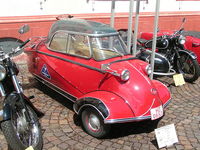Microcars Are Ready to Storm Europe
Small Car, Big Ambitions: Over 60 Base Models Set for Launch in the Next Three Years in the European Microcars Market
7 out of Top 10 Vehicle Manufacturers to Develop on Strong Revenue Potential of Microcars
 Modern microcar: 599-999 cc Smart car |
LONDON--27 June, 2011: The microcars segment is poised to become one of the largest revenue generators for over 30 market participants, including seven out of the top 10 global vehicle manufacturers (VMs). Challenged by tighter emission norms and safety requirements, the entire microcars market has evolved from being a highly protected and niche segment to an extremely focused one that even qualifies for vehicle crash tests.
New analysis from Frost & Sullivan (Frost and Sullivan Auto), Strategic Analysis of the European Microcars Market, finds that the European microcars market is expected to witness the introduction of over 60 base models, including quadricycles, by 2013. Moreover, over 19 models are projected for launch by top seven out of 10 OEMs in the entirely new emerging class of sub-A segment vehicles over the next three years. The sub-A vehicles segment is anticipated to grow faster than quadricycles due to their characteristics and striking resemblance to A-segment vehicles.
“The development of megacities, paralleled by changing mobility trends and growing interest in urban vehicles with low emissions and low fuel consumption, has encouraged VMs to introduce microcars in Europe,” notes Frost & Sullivan Industry Analyst Vishwas Shankar. “Greener agendas, government subsidies, parking charge exemptions and possible vehicle homologation rules of ‘no-license’ required to drive these vehicles could reinforce sales of microcars.”
In Europe, the focus on alternate fuel driven vehicles, congestion in city centres and increasing cost of vehicle ownership is expected to boost microcars sales over seven fold. Global mainstream OEMs have provided market momentum – over 30 models were introduced in the recently concluded 2010 Paris Motor Show and the 2011 Geneva Motor Show.
Over 75 per cent of the microcars announced are expected to be battery electric vehicles (EVs), with the major related challenges being range anxiety and limited speeds. Since their introduction, safety has been a cause of concern with the L6 and L7 quadricycles (L-category) and industry experts expect traces of this anxiety to persist in the microcars segment for a brief period.
Increasing legislative controls are also expected to pull down sales in the long term. This is likely due to the rising vehicle costs associated with the addition of new components recommended by legislation.
“VMs are pro-actively addressing stricter emission norm and increased safety level requirements with the introduction of sub-A segment vehicles,” remarks Shankar. “In contrast, conventional engine powered quadricycle manufacturers continue to be constrained by the need for high investment costs to upgrade their vehicles to match sub-A levels in terms of safety and emission norms.”
Unlike sub-A vehicles, conventional engine powered quadricycles do not qualify for subsidies/rebates, resulting in quadricycle manufacturers facing the prospect of attenuating profit margins. The introduction, therefore, of electric quadricycles is a promising sign as they have started to qualify for regional grants and benefits including access to high-occupancy vehicle lanes and parking charge exemptions.
“As a result, VMs are expected to introduce electric quadricycles in large numbers and even follow it with a sub-A vehicle (by increasing motor torque and power) to boost sales shipment,” adds Shankar. “Quadricycle manufacturers in Europe have also started to invest in new age business models driven by car sharing organisations, addressing thereby the challenge of increased vehicle ownership cost.”
Automakers such as Aixam Mega and Ligier Microcar are early entrants in announcing electric quadricycles in the European market. They have clear visions of growth strategy in this category – to commercialise electric quadricycles and reduce carbon footprint.
“However in Europe, automakers like Renault, PSA Peugeot Citroen, Tata Motors and many more have announced their entry in the microcars segment with sub-A vehicles,” concludes Shankar. “There is an evident market demand in the electric microcars category, stimulated by the growing needs of Gen-Y end consumers.”
Strategic Analysis of the European Microcars Market is part of the Automotive & Transportation Growth Partnership Service programme, which also includes research in the following markets: Sustainable and Innovative Personal Transport Solutions - Strategic Analysis of Carsharing Market in Europe, Analysis of the Market for Carsharing in North America, Strategic Analysis of Passenger Vehicle Market in Malaysia and Russian and CEE Automotive Industry Outlook. All research included in subscriptions provide detailed market opportunities and industry trends that have been evaluated following extensive interviews with market participants.
About Frost & Sullivan Frost & Sullivan, the Growth Partnership Company, enables clients to accelerate growth and achieve best-in-class positions in growth, innovation and leadership. The company's Growth Partnership Service provides the CEO and the CEO's Growth Team with disciplined research and best-practice models to drive the generation, evaluation, and implementation of powerful growth strategies. Frost & Sullivan leverages 50 years of experience in partnering with Global 1000 companies, emerging businesses and the investment community from more than 40 offices on six continents.



